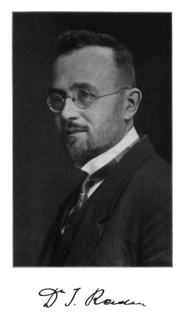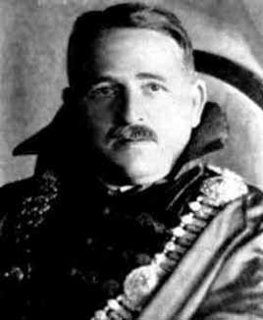There are several well-known theorems in functional analysis known as the Riesz representation theorem. They are named in honor of Frigyes Riesz.
In mathematics, a trace class operator is a compact operator for which a trace may be defined, such that the trace is finite and independent of the choice of basis. Trace class operators are essentially the same as nuclear operators, though many authors reserve the term "trace class operator" for the special case of nuclear operators on Hilbert spaces, and reserve "nuclear operator" for usage in more general Banach spaces.
In mathematical analysis, a function of bounded variation, also known as BV function, is a real-valued function whose total variation is bounded (finite): the graph of a function having this property is well behaved in a precise sense. For a continuous function of a single variable, being of bounded variation means that the distance along the direction of the y-axis, neglecting the contribution of motion along x-axis, traveled by a point moving along the graph has a finite value. For a continuous function of several variables, the meaning of the definition is the same, except for the fact that the continuous path to be considered cannot be the whole graph of the given function, but can be every intersection of the graph itself with a hyperplane parallel to a fixed x-axis and to the y-axis.
In functional analysis and related branches of mathematics, the Banach–Alaoglu theorem states that the closed unit ball of the dual space of a normed vector space is compact in the weak* topology. A common proof identifies the unit ball with the weak* topology as a closed subset of a product of compact sets with the product topology. As a consequence of Tychonoff's theorem, this product, and hence the unit ball within, is compact.
In functional analysis, a branch of mathematics, a compact operator is a linear operator L from a Banach space X to another Banach space Y, such that the image under L of any bounded subset of X is a relatively compact subset of Y. Such an operator is necessarily a bounded operator, and so continuous.
In mathematics, especially functional analysis, Bessel's inequality is a statement about the coefficients of an element in a Hilbert space with respect to an orthonormal sequence.
In mathematics, the Riesz–Fischer theorem in real analysis is any of a number of closely related results concerning the properties of the space L2 of square integrable functions. The theorem was proven independently in 1907 by Frigyes Riesz and Ernst Sigismund Fischer.
In mathematics, weak convergence in a Hilbert space is convergence of a sequence of points in the weak topology.
In mathematics, a nuclear operator is a compact operator for which a trace may be defined, such that the trace is finite and independent of the choice of basis . Nuclear operators are essentially the same as trace class operators, though most authors reserve the term "trace class operator" for the special case of nuclear operators on Hilbert spaces.
In mathematics, a sequence of vectors (xn) in a Hilbert space is called a Riesz sequence if there exist constants such that
In functional analysis, the concept of a compact operator on Hilbert space is an extension of the concept of a matrix acting on a finite-dimensional vector space; in Hilbert space, compact operators are precisely the closure of finite-rank operators in the topology induced by the operator norm. As such, results from matrix theory can sometimes be extended to compact operators using similar arguments. By contrast, the study of general operators on infinite-dimensional spaces often requires a genuinely different approach.
In mathematics, the Opial property is an abstract property of Banach spaces that plays an important role in the study of weak convergence of iterates of mappings of Banach spaces, and of the asymptotic behaviour of nonlinear semigroups. The property is named after the Polish mathematician Zdzisław Opial.
In functional analysis, the Dunford–Pettis property, named after Nelson Dunford and B. J. Pettis, is a property of a Banach space stating that all weakly compact operators from this space into another Banach space are completely continuous. Many standard Banach spaces have this property, most notably, the space C(K) of continuous functions on a compact space and the space L1(μ) of the Lebesgue integrable functions on a measure space. Alexander Grothendieck introduced the concept in the early 1950s, following the work of Dunford and Pettis, who developed earlier results of Shizuo Kakutani, Kōsaku Yosida, and several others. Important results were obtained more recently by Jean Bourgain. Nevertheless, the Dunford–Pettis property is not completely understood.
In mathematics, a square-integrable function, also called a quadratically integrable function, is a real- or complex-valued measurable function for which the integral of the square of the absolute value is finite. Thus, square-integrability on the real line is defined as follows.
In mathematics, Delta-convergence, or Δ-convergence, is a mode of convergence in metric spaces, weaker than the usual metric convergence, and similar to the weak convergence in Banach spaces. In Hilbert space, Delta-convergence and weak convergence coincide. For a general class of spaces, similarly to weak convergence, every bounded sequence has a Delta-convergent subsequence. Delta convergence was first introduced by Teck-Cheong Lim, and, soon after, under the name of almost convergence, by Tadeusz Kuczumow.
In mathematics, in the areas of topology and functional analysis, the Anderson–Kadec theorem states that any two infinite dimensional, separable Banach spaces, or more generally Fréchet spaces are homeomorphic as topological spaces. The theorem was proved by Mikhail Kadets (1966) and Richard Davis Anderson.










